Eucharistic Revival
Our world is hurting. We all need healing, yet many of us are separated from the very source of our strength. Jesus Christ invites us to return to the source and summit of our faith in the celebration of the Eucharist. The National Eucharistic Revival is a movement to restore understanding and devotion to this great mystery here in the United States by helping us renew our worship of Jesus Christ in the Eucharist.
Watch the video to learn more about the exciting journey ahead and how you can be a part of it!
https://www.eucharisticrevival.org/
Pray the Corpus Christi Novena with us June 2–10, 2023! Access the novena here today. You can also pray along with the free Amen App or get daily emails from Pray More Novenas.
Don’t miss Bishop Cozzens’ special invitation video for the Year of Parish Revival!

See below to watch Fr. Mark’s three part preaching series.

In Part II of his Eucharistic Revival preaching series, Fr. Mark presented and explained the external signs that help order our interior disposition to the true presence of Jesus in the Eucharist.
Communion Paten
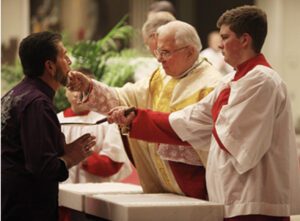
A Communion paten is a small plate that is held by an altar server or acolyte during the distribution of Holy Communion. It is placed under the the chin or the hands of the communicant to ensure that the host, or particles of the host do not fall to the ground. The patens are then purified over the chalice by the priest or deacon, and the chalice is purified with water, which is drunk by the priest or deacon.
Incense
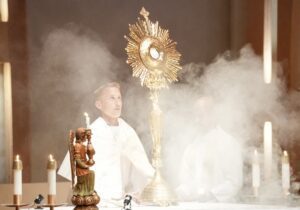 Not only does the smoke symbolize the prayers of the faithful drifting up to heaven, incense actually creates the ambiance of heaven. The Book of Revelation describes the heavenly worship as follows: “Another angel came in holding a censer of gold. He took his place at the altar of incense and was given large amounts of incense to deposit on the altar of gold in front of the throne, together with the prayers of all God’s holy ones. From the angel’s hand, the smoke of the incense went up before God, and with it the prayers of God’s people.” Hence, incense connects us to God’s altar in heaven and allows us to utilize all of our senses in our prayer.
Not only does the smoke symbolize the prayers of the faithful drifting up to heaven, incense actually creates the ambiance of heaven. The Book of Revelation describes the heavenly worship as follows: “Another angel came in holding a censer of gold. He took his place at the altar of incense and was given large amounts of incense to deposit on the altar of gold in front of the throne, together with the prayers of all God’s holy ones. From the angel’s hand, the smoke of the incense went up before God, and with it the prayers of God’s people.” Hence, incense connects us to God’s altar in heaven and allows us to utilize all of our senses in our prayer.
The usage of incense adds a sense of solemnity and mystery to the Mass. The visual imagery of the smoke and the smell reminds us of the transcendence of the Mass which links heaven with earth, and allows us to enter into the presence of God.
According to the General Instruction of the Roman Missal incense may be used during the entrance procession; at the beginning of Mass, to incense the altar; at the procession and proclamation of the Gospel; at the offertory, to incense the offerings, altar, priest and people; and at the elevation of the Sacred Host and chalice of Precious Blood after the consecration.
Chalice Veil
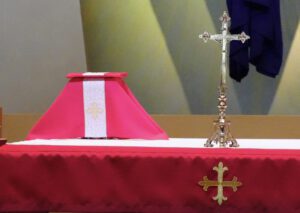
Small silk cloth, typically of the same color as the priest’s vestments, used to cover the Chalice and protect the Precious Blood form insects, dust, bugs, etc.
Chalice
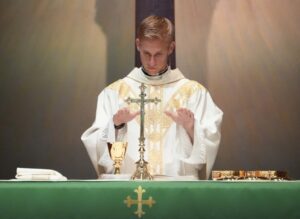 The consecrated gold or gilded silver cup used to hold the Precious Blood.
The consecrated gold or gilded silver cup used to hold the Precious Blood.
When Mass begins, the Chalice is covered by the folded purificator and the pall.
The Sanctuary Lamp
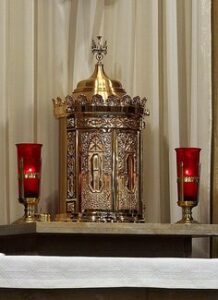 In honor of Jesus Christ a lamp burns perpetually before the altar. The Christian soul longs to remain in constant adoration at the feet of Our Lord, there to be consumed by gratitude and love. In Heaven alone will this happiness be given to us, but here below, as an expression of our devout desires, we place a lamp in the sanctuary to take our place. In this little light St. Augustine shows us an image of the three Christian virtues. Its clearness is faith, which enlightens our mind; its warmth is love, which fills our heart; its flame, which, trembling and agitated, mounts upward till it finds rest in its center, is hope, with its aspirations toward Heaven, and its troubles outside of God. (Serm. 67, de Script.)
In honor of Jesus Christ a lamp burns perpetually before the altar. The Christian soul longs to remain in constant adoration at the feet of Our Lord, there to be consumed by gratitude and love. In Heaven alone will this happiness be given to us, but here below, as an expression of our devout desires, we place a lamp in the sanctuary to take our place. In this little light St. Augustine shows us an image of the three Christian virtues. Its clearness is faith, which enlightens our mind; its warmth is love, which fills our heart; its flame, which, trembling and agitated, mounts upward till it finds rest in its center, is hope, with its aspirations toward Heaven, and its troubles outside of God. (Serm. 67, de Script.)
Corporal
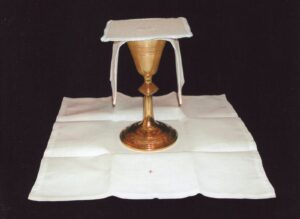

Please watch the accompanying Ascension Presents video for the proper interior disposition and external postures for receiving Holy Communion on the tongue.
If you are receiving Communion on the tongue, please be sure to lower your
‘prayer hands’ while receiving so the Priest/minister can properly place the host on your tongue.
| The Eucharist and the Sacred Heart of Jesus |
| By Servant of God Fr. John Hardon, S.J. It is impossible to identify the Holy Eucharist too closely with Jesus Christ. We should remember He is in the Holy Eucharist not merely with His substance. I have corrected many of my students over the years who tell me, “Transubstantiation means that the substance of bread and wine become the substance of Jesus Christ.” I reply, “No, transubstantiation means the substance of bread and wine are no longer there. The substance of bread and wine is replaced not only by the substance of Christ’s Body and Blood. What replaces the substance of bread and wine is Jesus Christ!” Everything that makes Christ, Christ replaces what had been the substance of bread and wine. The substance of bread and wine become the whole Christ. Therefore, Christ in the Holy Eucharist is here with His human heart. Is it a living heart? Yes! That is why the revelations our Lord made to St. Margaret Mary about promoting devotion to the Sacred Heart were all made from the Holy Eucharist. Why do we equate the Sacred Heart with the Holy Eucharist? Because the Holy Eucharist is the whole Christ with His human heart. According to St. Margaret Mary, the Sacred Heart is the Holy Eucharist. So it follows that devotion to the Sacred Heart is devotion to the Holy Eucharist. It is infinite Love Incarnate living in our midst in the Blessed Sacrament. The Month of June is dedicated to the Sacred Heart of Jesus. |
